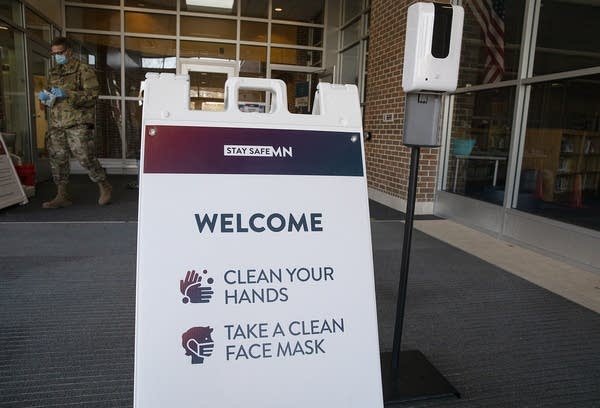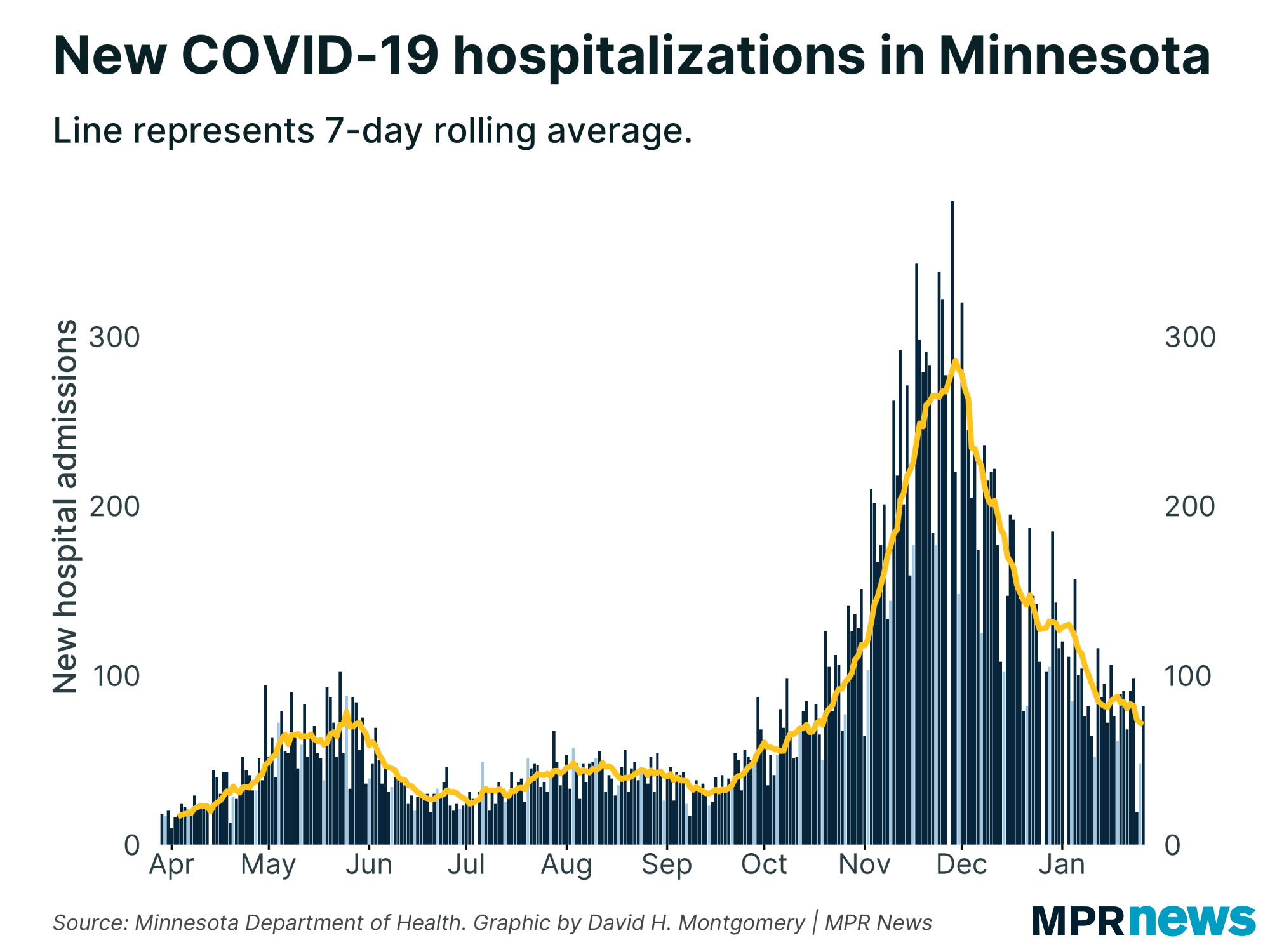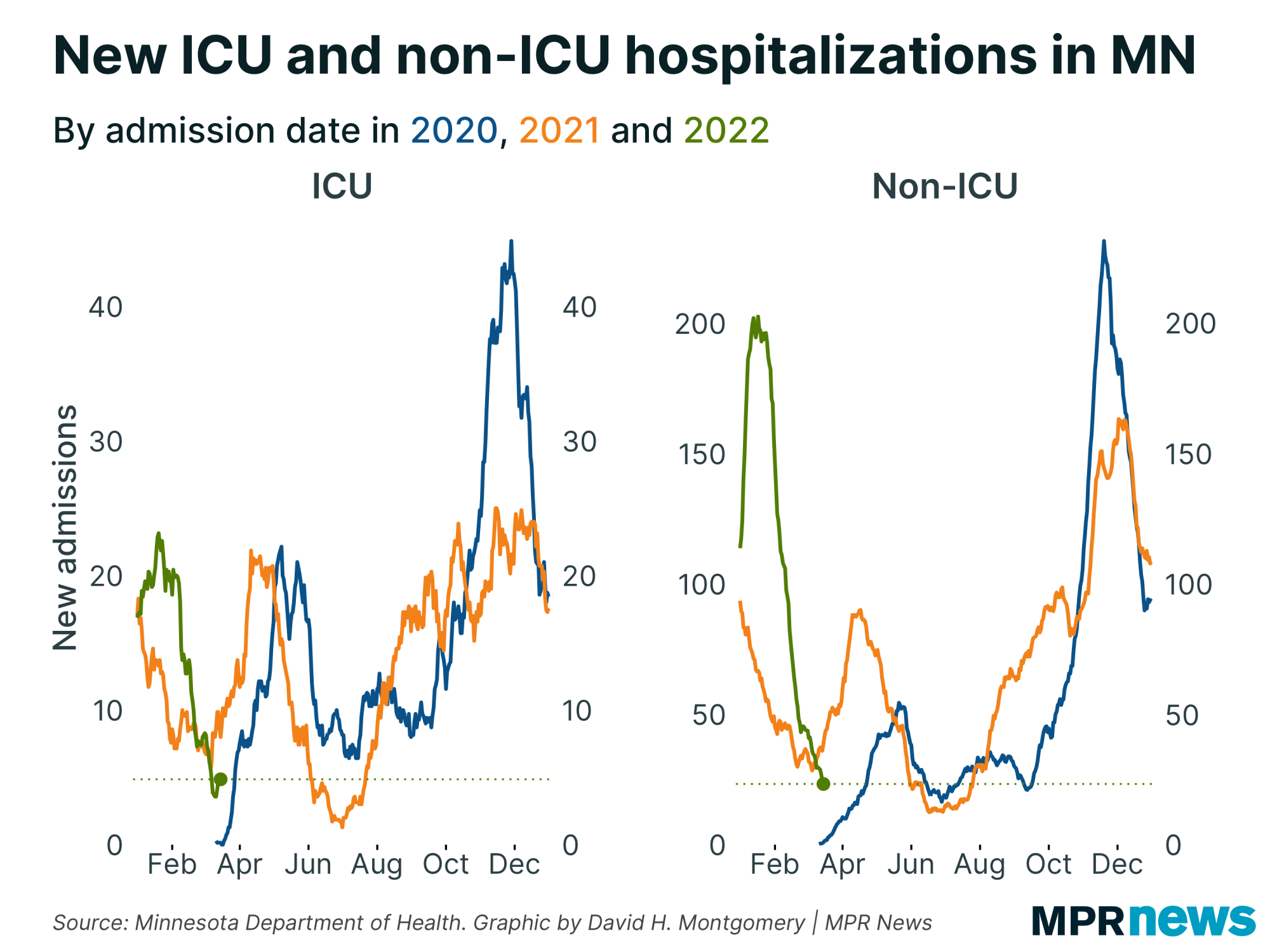Jan. 3 update on COVID-19 in MN: Watching for a possible change in trends

Go Deeper.
Create an account or log in to save stories.
Like this?
Thanks for liking this story! We have added it to a list of your favorite stories.
Minnesota enters the first full week of 2021 with COVID-19 numbers in a much better place than they were a month ago.
But there have been signs in recent days that a weekslong downward trend in new cases, hospital admissions and test positivity rates might be leveling off.
Sunday's update from state health officials covered two days' worth of data, catching up from the New Year's Day holiday. That temporarily muddles the weekly averages that can show pandemic trends better than the day-to-day numbers.
But prior to Sunday's updated numbers, there were signs of a possible stall in what had been a steady decline in several key metrics.
Turn Up Your Support
MPR News helps you turn down the noise and build shared understanding. Turn up your support for this public resource and keep trusted journalism accessible to all.
The average test positivity rate over the past week is now about 7.1 percent in Minnesota — up from about 4.7 percent last Sunday. Average daily case counts had increased from about 1,700 early last week, to nearly 1,900 as of Saturday’s update.
It remains too early to tell whether those upticks are a short-term aberration or if they will endure — and some reporting of statistics might be affected by the end-of-year holidays. It’s something that will be closely monitored as we head further into January — and officials already were watching for signs of any case increases that might be tied to holiday gatherings.

COVID-19 vaccinations continue around the state. As of Saturday’s update from the Minnesota Department of Health, just over 57,000 people had received at least one of the two-shot Pfizer or Moderna vaccines; that figure was not updated on Sunday. Health care workers and long-term care facility residents have priority for the limited number of doses currently available.
The state has so far received nearly 170,000 doses of the Pfizer vaccine and nearly 128,000 of the Moderna vaccine.

Here are Minnesota’s current COVID-19 statistics, reported on Sunday and covering two days’ worth of data:
5,430 deaths (53 new)
420,544 positive cases (2,714 new), 403,419 off isolation (96 percent)
5.7 million tests, 3 million people tested (about 52 percent of the population)
7.1 percent seven-day positive test rate (officials find 5 percent concerning)


Caseloads spread across age groups
People in their 20s still make up the age bracket with the state’s largest number of confirmed cases — more than 80,000 since the pandemic began, including more than 42,000 among people ages 20 to 24.

The number of high school-age youth confirmed with the disease has also grown, with more than 32,000 total cases among those ages 15 to 19 since the pandemic began.
Although less likely to feel the worst effects of the disease and end up hospitalized, experts worry youth and young adults will spread it to older relatives and members of other vulnerable populations.
It’s of particular concern because people can have the coronavirus and spread COVID-19 when they don’t have symptoms.

New cases ebb across Minnesota
Central and western Minnesota drove much of the increase in new cases over the past two months, while Hennepin and Ramsey counties showed some of the slowest case growth in the state.
Cases continue to fall statewide, with most regions dipping down to levels before the state’s COVID-19 surge that hit in November and early December.

Hot spots continue to pop up in rural counties relative to their population.

Caseloads still heaviest among people of color
In Minnesota and across the country, COVID-19 has hit communities of color disproportionately hard in both cases and deaths. That’s been especially true for Minnesotans of Hispanic descent for much of the pandemic.

Even as new case counts ease from their peak a few weeks ago, the data shows people of color continue to be hit hardest.
Distrust of the government, together with deeply rooted health and economic disparities, have hampered efforts to boost testing among communities of color, officials say, especially among unauthorized immigrants who fear their personal information may be used to deport them.
Similar trends have been seen among Minnesota’s Indigenous residents. Counts among Indigenous people jumped in October relative to population.
Developments around the state
Sauk Centre hospital returns to routine operations as COVID-19 patient number drops
A Sauk Centre, Minn., hospital temporarily designated for patients with COVID-19 returned to normal operations last week.
In November, CentraCare designated its hospital in Sauk Centre for less critical patients with COVID-19. The move was aimed at easing pressure on its largest hospital in St. Cloud, Minn., where the sickest patients are treated.
Since then, the numbers of people admitted to the hospital and intensive care unit have declined.
Dr. George Morris, medical incident commander for CentraCare's COVID-19 response team, says the number of patients in the ICU has dropped from a high of 59 to more normal levels of 17 to 22 daily.
"We're at a point now, where we can see that we're consistently on the downward trend, and that we can push them back into more of their regular work,” Morris said. “We have more employees on site. And we've managed ways. Each time we go through these crises, we learn."
Morris said staffing levels also are back closer to normal. At one point, roughly 10 percent of CentraCare's 13,000 employees were out due to exposure to or testing positive for the virus, or caring for a family member.
As of last week more than 2,000 CentraCare employees had received a first dose of COVID-19 vaccine, along with residents and staff of five long-term care facilities, Morris said.
— Kirsti Marohn | MPR News
Top headlines
106-year-old COVID survivor receives vaccine in central Minnesota: At Carris Health Care Center and Therapy Suites in Willmar, Minn., 20 residents received initial doses on Tuesday. The first to receive a vaccine was Harriet Lobbins. She recovered after having COVID-19 in mid-November.
Opposition to Minnesota's bar and restaurant COVID-19 restrictions still bubbling: Gov. Tim Walz’s emergency restrictions on inside drinking and dining run through Jan. 10, and opponents say some establishments continue to quietly defy the order. Minnesota Attorney General Keith Ellison said he’ll continue to bring cases against businesses that are not complying.
California announces first confirmed case of COVID-19 variant: California has announced its first confirmed case of the new and apparently more contagious variant of the coronavirus. It was the second such case documented in the U.S. in a day.
Pandemic brings a Dakota woman home to southern Minnesota: Back in March, reporter Dan Kraker met Pat Northrup in her Cloquet, Minn., apartment where she danced a jingle dress dance with her family and friends. Since then, the pandemic has upended her life; someone in her apartment contracted the virus and Northrup, who's now 70, decided to move to her daughter's house, only a few miles west of the Lower Sioux Indian Community where she grew up.
COVID-19 in Minnesota
Data in these graphs are based on the Minnesota Department of Health's cumulative totals released at 11 a.m. daily. You can find more detailed statistics on COVID-19 at the Health Department website.
Dear reader,
Political debates with family or friends can get heated. But what if there was a way to handle them better?
You can learn how to have civil political conversations with our new e-book!
Download our free e-book, Talking Sense: Have Hard Political Conversations, Better, and learn how to talk without the tension.




